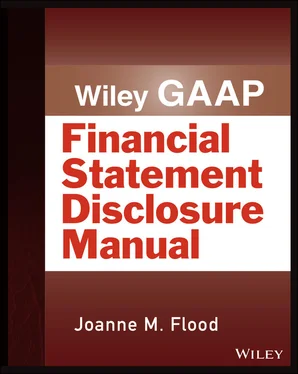Example 7.20: Use of Estimates and AssumptionsThe preparation of consolidated financial statements in conformity with U.S. GAAP requires management to make estimates and assumptions that affect the reported amounts of assets and liabilities and disclosure of contingent assets and liabilities at the date of the consolidated financial statements and the reported amounts of revenues and expenses during the reporting period. The Company regularly evaluates estimates and assumptions. The Company bases its estimates and assumptions on current facts, historical experience and various other factors that it believes to be reasonable under the circumstances, the results of which form the basis for making judgments about the carrying values of assets and liabilities and the accrual of costs and expenses that are not readily apparent from other sources. The actual results experienced by the Company may differ materially and adversely from the Company's estimates. To the extent there are material differences between the estimates and the actual results, future results of operations will be affected.
Example 7.21: Fair Value of Financial InstrumentsFor certain of the Company's financial instruments, including cash and equivalents, restricted cash, accounts receivable, advances to suppliers, accounts payable, accrued liabilities and short‐term debt, the carrying amounts approximate their fair values due to their short maturities.
FASB ASC Topic 820, Fair Value Measurements and Disclosures , requires disclosure of the fair value of financial instruments held by the Company. FASB ASC Topic 825, Financial Instruments , defines fair value, and establishes a three‐level valuation hierarchy for disclosures of fair value measurement that enhances disclosure requirements for fair value measures. The carrying amounts reported in the consolidated balance sheets for receivables and current liabilities each qualify as financial instruments and are a reasonable estimate of their fair values because of the short period of time between the origination of such instruments and their expected realization and their current market rate of interest. The three levels of valuation hierarchy are defined as follows:
Level 1 inputs to the valuation methodology are quoted prices for identical assets or liabilities in active markets.
Level 2 inputs to the valuation methodology include quoted prices for similar assets and liabilities in active markets, quoted prices for identical or similar assets in inactive markets, and inputs that are observable for the asset or liability, either directly or indirectly, for substantially the full term of the financial instrument.
Level 3 inputs to the valuation methodology us one or more unobservable inputs which are significant to the fair value measurement.
The Company analyzes all financial instruments with features of both liabilities and equity under FASB ASC Topic 480, Distinguishing Liabilities from Equity , and FASB ASC Topic 815, Derivatives and Hedging .
As of August 31, 20X8 and 20X7, respectively, the Company did not identify any assets and liabilities required to be presented on the balance sheet at fair value.
Example 7.22: Derivative Financial InstrumentsThe Company uses derivative financial instruments to manage its exposure to certain foreign currency exchange rate risks.
Net investment hedges . The Company enters into certain forward currency contracts that are designated as net investment hedges. The effective portions of the hedges are reported in accumulated other comprehensive income or loss, net of tax, and will subsequently be reclassified to net earnings in the period in which the hedged investment is either sold or substantially liquidated. Hedge effectiveness is measured using a method based on changes in forward exchange rates. The Company classifies the cash flows at settlement of its net investment hedges within investing activities in the consolidated statements of cash flows.
Derivatives not designated as hedging instruments . The Company also enters into certain forward currency contracts that are not designated as net investment hedges. They are designed to economically hedge the foreign exchange revaluation gains and losses of certain monetary assets and liabilities. The Company has not applied hedge accounting to these instruments and the change in fair value of these derivatives is recorded within selling, general and administrative expenses. The Company classifies the cash flows at settlement of its forward currency contracts which are not designated in hedging relationships within operating activities in the consolidated statements of cash flows.
The Company presents its derivative assets and derivative liabilities at their gross fair values within other prepaid expenses and other current assets and other current liabilities on the consolidated balance sheets. However, the Company's Master International Swap Dealers Association, Inc., Agreements and other similar arrangements allow net settlements under certain conditions.
The Company does not enter into derivative contracts for speculative or trading purposes. Additional information on the Company's derivative financial instruments is included in Notes 14 and 15 of these consolidated financial statements.
Foreign Currency Transactions
Example 7.23: Foreign Currency Transactions and Comprehensive IncomeGAAP generally requires recognized revenue, expenses, gains and losses be included in net income. Certain statements, however, require entities to report specific changes in assets and liabilities, such as gain or loss on foreign currency translation, as a separate component of the equity section of the balance sheet. Such items, along with net income, are components of comprehensive income. The functional currency of the Company's Australian subsidiaries is the Australian dollar. Translation gains of $605,430 and $616,738 for the years ended August 31, 20X2 and 20X1, respectively, are classified as an item of other comprehensive income in the stockholders' equity section of the balance sheet.
Example 7.24: Taxation, Including Tax Cuts and Jobs Act DisclosureThe Company uses the liability method of accounting for income taxes in accordance with U.S. Generally Accepted Accounting Principles (“U.S. GAAP”). Deferred taxes, if any, are recognized for the future tax consequences of temporary differences between the tax basis of assets and liabilities and their reported amounts in the consolidated financial statements. A valuation allowance is provided against deferred tax assets if it is more likely than not that the asset will not be utilized in the future.
The Company recognizes the tax benefit from an uncertain tax position only if it is more likely than not that the tax position will be sustained on examination by the taxing authorities, based on the technical merits of the position. The Company recognizes interest and penalties, if any, related to unrecognized tax benefits as income tax expense. The Company had no uncertain tax positions as of June 30, 20X8 and 20X7, respectively.
Income tax returns for the years prior to 20X4 are no longer subject to examination by U.S. tax authorities.
On December 22, 2017, the “Tax Cuts and Jobs Act” (the “Act”) was enacted. Under the provisions of the Act, the U.S. corporate tax rate decreased rom 35% to 21%. As the Company has a June 30 fiscal year‐end, the lower corporate income tax rate will be phased in, resulting in a U.S. statutory federal rate of approximately 28% for our fiscal year ending June 30, 2018, and 21% for subsequent fiscal years. Additionally, the Tax Act imposes a one‐time transition tax on deemed repatriation of historical earnings of foreign subsidiaries, and future foreign earnings are subject to U.S. taxation. The change in rate has caused the Company to remeasure all U.S. deferred income tax assets and liabilities for temporary differences and net operating loss (“NOL”) carryforwards and recorded a one‐time transition tax expense.
Читать дальше












